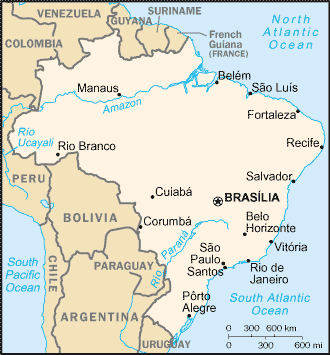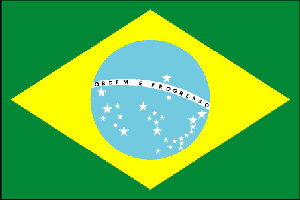
|
Brazil
Background:
Following three centuries under the rule of Portugal, Brazil became an
independent nation in 1822. By far the largest and most populous country in
South America, Brazil has overcome more than half a century of military
intervention in the governance of the country to pursue industrial and
agricultural growth and development of the interior. Exploiting vast natural
resources and a large labor pool, Brazil became South America's leading
economic power by the 1970s. Highly unequal income distribution remains a
pressing problem.
Location:
Eastern South America, bordering the Atlantic Ocean
Area: Total: 8,511,965 sq km, land: 8,456,510 sq km, water: 55,455 sq km.
Area - comparative: Slightly smaller than the US
Land boundaries: Total: 14,691 km, border countries: Argentina 1,224 km,
Bolivia 3,400 km, Colombia 1,643 km, French Guiana 673 km, Guyana 1,119 km,
Paraguay 1,290 km, Peru 1,560 km, Suriname 597 km, Uruguay 985 km, Venezuela
2,200 km.
Coastline: 7,491 km
Climate and Terrain:
Climate: Mostly tropical, but temperate in south
Terrain: Mostly flat to rolling lowlands in north; some plains, hills,
mountains, and narrow coastal belt
Elevation extremes: Lowest point: Atlantic Ocean 0 m highest point: Pico da
Neblina 3,014 m
Natural resources: Bauxite, gold, iron ore, manganese, nickel, phosphates,
platinum, tin, uranium, petroleum, hydropower, timber
People:
Population: 176,029,560.
Ethnic groups: White (includes Portuguese, German, Italian, Spanish, Polish)
55%, mixed white and black 38%, black 6%, other (includes Japanese, Arab,
Amerindian) 1%.
Religions: Roman Catholic (nominal) 80%.
Languages: Portuguese (official), Spanish, English, French.
Government:
Government type: Federative republic.
Capital: Brasilia.
Independence: 7 September 1822 (from Portugal).
Economy overview:
Possessing large and well-developed agricultural, mining, manufacturing, and
service sectors, Brazil's economy outweighs that of all other South American
countries and is expanding its presence in world markets. The maintenance of
large current account deficits via capital account surpluses became problematic
as investors became more risk averse to emerging market exposure as a
consequence of the Asian financial crisis in 1997 and the Russian bond default
in August 1998. After crafting a fiscal adjustment program and pledging
progress on structural reform, Brazil received a $41.5 billion IMF-led
international support program in November 1998. In January 1999, the Brazilian
Central Bank announced that the real would no longer be pegged to the US
dollar.
GDP - composition by sector: agriculture: 9% industry: 32% services: 59%.
Statistics:
Telephones - main lines in use: 17.039 million.
Telephones - mobile cellular: 4.4 million.
Radio broadcast stations: AM 1,365, FM 296.
Radios: 71 million.
Television broadcast stations: 138.
Televisions: 36.5 million.
Internet users: 11.94 million.
Highways: Total: 1.98 million km, paved: 184,140 km, unpaved: 1,795,860 km.
Airports: 3,365.
Airports - with paved runways: 627, with unpaved runways: 2,738.
Return to Visiting Locations
|

